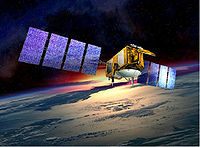
Photo from wikipedia
Three year long current‐meter arrays were deployed in the Malvinas Current at 41°S below a satellite altimeter track at about 10 years intervals. Surface geostrophic velocities (SGV) derived from satellite… Click to show full abstract
Three year long current‐meter arrays were deployed in the Malvinas Current at 41°S below a satellite altimeter track at about 10 years intervals. Surface geostrophic velocities (SGV) derived from satellite altimetric data are compared with the in situ velocities at the upper current meter (∼300 m). Multisatellite gridded SGV compare better with in situ observations than along‐track SGV. In spite of the proximity of the moorings to the complex Brazil‐Malvinas Confluence (BMC) region, satellite SGV are significantly correlated with the 20 day low‐passed in situ velocities (0.85 for along‐isobaths velocities, 0.8 for cross‐isobaths velocities). The recent in situ measurement period (2014–2015) stands out in the altimetry record with a long‐lasting (4 months) high level of eddy kinetic energy at the mooring site and a southernmost location of the Subantarctic Front (SAF). The first two modes of variations of sea level anomaly (SLA) over the BMC remarkably match the first two modes of the low‐passed in situ velocities. The first mode is associated with a latitudinal migration of the SAF, and the second with a longitudinal displacement of the Brazil Current overshoot. The two modes dominate the 24 year long record of SLA in the BMC, with energy peaks at the annual and semiannual periods for the first mode and at 3–5 months for the second mode. The SLA over the Southwest Atlantic was regressed onto the two confluence modes of SLA variations and showed remarkable standing wave train like structures in the Argentine Basin.
Journal Title: Journal of Geophysical Research
Year Published: 2017
Link to full text (if available)
Share on Social Media: Sign Up to like & get
recommendations!